Pearson biology chapter 3 - Study guides, Class notes & Summaries
Looking for the best study guides, study notes and summaries about Pearson biology chapter 3? On this page you'll find 23 study documents about Pearson biology chapter 3.
All 23 results
Sort by
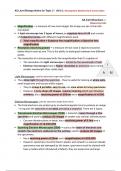 Popular
Popular
-
Unit 2 Summary Edexcel International A Level Biology - Chapter 3
- Summary • 15 pages • 2024
- Available in package deal
-
- $8.19
- 1x sold
- + learn more
Concise and coloured notes for Pearson Edexcel's International A Level Biology sat in January, June or October. This document follows the IAL specification and textbook order, covering all the topics in Unit 2, specifically Chapter 3: Cell Structure, Reproduction and Development.
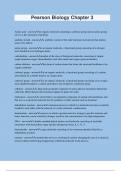
-
Pearson Biology Chapter 3
- Exam (elaborations) • 3 pages • 2024
-
- $10.49
- + learn more
ent of the male hormone testosterone that mimics some of its effects amino group - answerin an organic molecule, a functional group consisting of a nitrogen atom bonded to two hydrogen atoms carbohydrate - answermember of the class of biological molecules consisting of simple single-monomer sugars (disacchardies) and other multi-unit sugars (polysaccharides) carbon skeleton - answerthe chain of carbon atoms that forms the structural backbone of an organic molecule carbonyl group - answer...
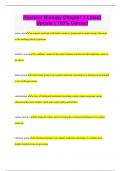
-
Pearson Biology Chapter 3 Latest Update | 100% Correct
- Exam (elaborations) • 7 pages • 2024
-
- $10.09
- + learn more
Pearson Biology Chapter 3 Latest Update | 100% Correct amino acid an organic molecule with both a carboxyl group and an amino group; functions as the building block of proteins anabolic steroid a synthetic variant of the male hormone testosterone that replicates some of its effects amino group a functional group in an organic molecule consisting of a nitrogen atom bonded to two hydrogen atoms carbohydrate a class of biological molecules including simple single-monomer sugars (disacchari...

-
Test Bank Biopsychology (10th Edition) by John P. J. Pinel
- Exam (elaborations) • 1304 pages • 2024
-
- $17.99
- + learn more
Biopsychology 10th Edition by Pinel Test Bank Stuvia Is Available For Download After Purchase. In Case You Encounter Any Difficulties with Download or want the document in a Different Format, Please Feel Free to Contact Me via Inbox. I Will Promptly Sort You. Thank You Test Bank Biopsychology (10th Edition) by John P. J. Pinel is your essential study companion for mastering biological psychology. You'll find comprehensive exam questions and practice tests covering brain and behavior ...
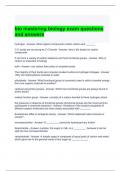
-
Mastering Biology Exam Bundle
- Package deal • 33 items • 2024
-
- $40.49
- + learn more
1 Exam (elaborations) Unit 1 Mastering Biology Exam Questions and Answers 2 Exam (elaborations) Pearson Mastering Biology Chapter 1 Exam Questions and Answers 3 Exam (elaborations) MyLab and Mastering Biology Chapter 1 and 2 Exam Questions and Answers 4 Exam (elaborations) Mastering Biology Unit 2 Exam Questions and Answers 5 Exam (elaborations
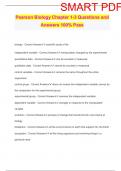
-
Pearson Biology Chapter 1-3 Questions and Answers 100% Pass
- Exam (elaborations) • 11 pages • 2024
- Available in package deal
-
- $12.49
- + learn more
Pearson Biology Chapter 1-3 Questions and Answers 100% Pass biology - Correct Answer️️ -scientific study of life independent variable - Correct Answer️️ -manipulated; changed by the experimenter quantitative data - Correct Answer️️ -can be counted or measured qualitative data - Correct Answer️️ -cannot be counted or measured control variables - Correct Answer️️ -remains the same throughout the entire experiment control group - Correct Answer️️ -does not receive th...
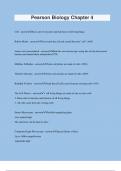
-
Pearson Biology Chapter 4
- Exam (elaborations) • 5 pages • 2024
-
- $10.49
- + learn more
Pearson Biology Chapter 4 Cell - answerBasic unit of structure and function of all living things Robert Hooke - answerDiscovered the cell and coined the term "cell" (1665) Anton van Leeuwenhoek - answerMade his own microscope, using this tool he discovered bacteria and named them animalcules(1974) Matthias Schleiden - answerNotices all plants are made of cells (1838) Theodor Schwann - answerNotices all animals are made of cells (1839) Rudolph Virchow - answerFound that all cells come fr...
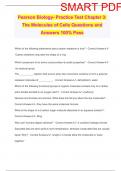
-
Pearson Biology- Practice Test Chapter 3: The Molecules of Cells Questions and Answers 100% Pass
- Exam (elaborations) • 3 pages • 2024
-
- $10.49
- + learn more
Pearson Biology- Practice Test Chapter 3: The Molecules of Cells Questions and Answers 100% Pass Which of the following statements about carbon skeletons is true? - Correct Answer️️ - -Carbon skeletons may take the shape of a ring. Which component of an amino acid provides its acidic properties? - Correct Answer️️ - -its carboxyl group The __________ reaction that occurs when two monomers combine to form a polymer releases molecules of __________. - Correct Answer️️ --dehydra...
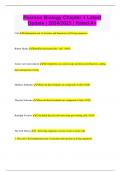
-
Pearson Biology Chapter 4 Latest Update | 2024/2025 | Rated A+
- Exam (elaborations) • 7 pages • 2024
-
- $10.09
- + learn more
Pearson Biology Chapter 4 Latest Update | 2024/2025 | Rated A+ Cell Fundamental unit of structure and function in all living organisms Robert Hooke Identified and named the "cell" (1665) Anton van Leeuwenhoek Developed his own microscope and discovered bacteria, calling them animalcules (1674) Matthias Schleiden Observed that all plants are composed of cells (1838) Theodor Schwann Observed that all animals are composed of cells (1839) Rudolph Virchow Concluded that all cells arise from...
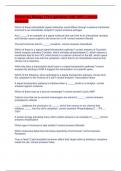
-
Mastering Biology-Exam (A GRADED) Combined questions with 100% correct answers
- Package deal • 8 items • 2023
-
- $43.49
- + learn more
Mastering Biology (Test questions with 100% correct answers) Chapter 1-3 Mastering Biology (Practice questions with 100% correct answers) Mastering Biology CH. 3&4 (Pearson) All possible questions with complete answers)

How much did you already spend on Stuvia? Imagine there are plenty more of you out there paying for study notes, but this time YOU are the seller. Ka-ching! Discover all about earning on Stuvia


